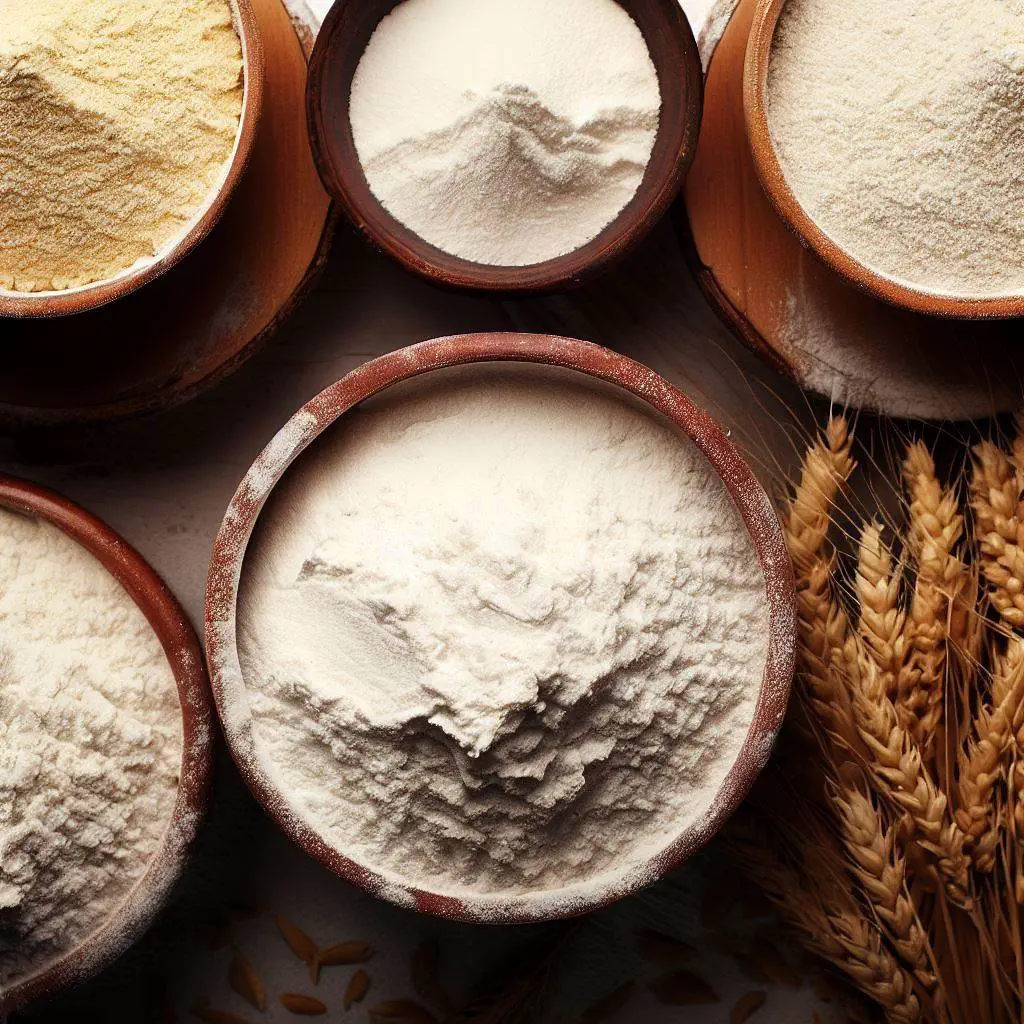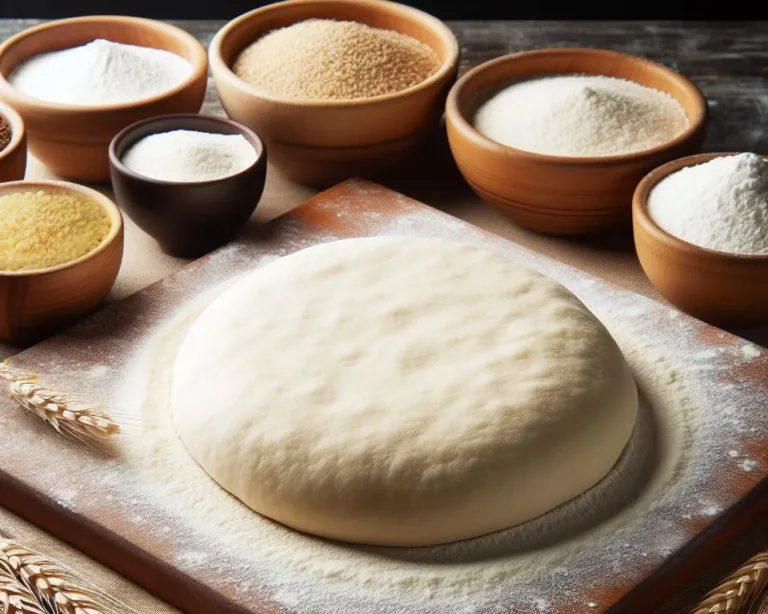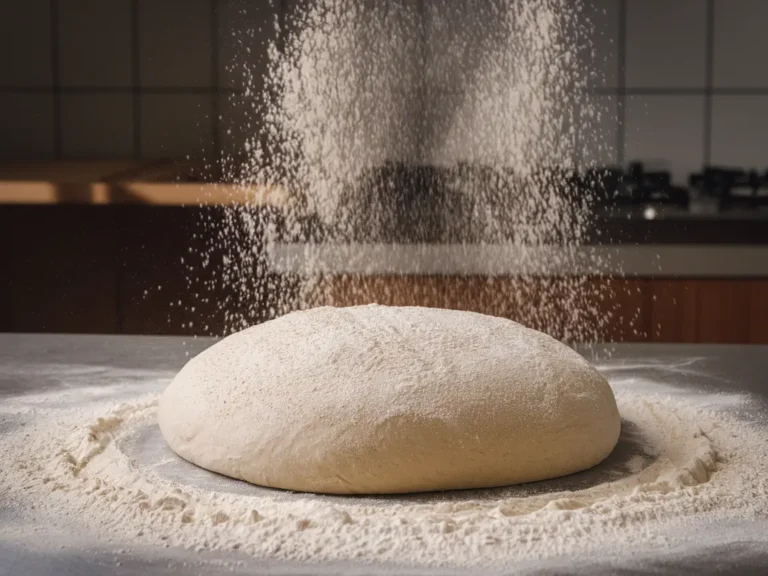Does Flour Affect Pizza Crust Flavor? [Why It Matters Less Than You Think]
Many people believe that flour influences the flavor of pizza crust (or any baked good, for that matter) – but is that really true? In this article, we’ll settle the question once and for all: does flour actually affect the flavor of pizza dough and the baked crust – and if so, how?
Introduction: How Flour Affects the Flavor of Pizza
Disclaimer: For clarity and ease of reading, this article has been excerpted from The Complete Guide to Pizza Flour (a recommended read), and focuses specifically on the topic of how flour affects flavor.
Flour is made up of three main components: endosperm, bran, and germ:

- The endosperm, found at the core of the wheat kernel, is mostly starch (70-75%) and protein. It’s white in color and nearly flavorless.
- The germ, and especially the bran, give wheat (and flour) its natural flavor – earthy, nutty, and slightly bitter. Their colors range from beige-golden (germ) to reddish-brown (bran).
- White flour is made exclusively from the endosperm. During milling, the bran and germ are removed, which is why white flour is white in color and neutral in taste.
- Wholemeal flour includes the entire wheat kernel – endosperm, bran, and germ– resulting in its darker gray-brown color and a pronounced wheat flavor.
- White flours may still contain tiny amounts of bran and germ, depending on the milling process. This is measured by the flour’s ash content: the more thoroughly the flour is refined (intentionally or not), the lower its ash (bran & germ) content – and the less flavor it contributes.
Now, let’s look at how all this impacts the flavor of your dough.
The Effect of White Flour on Flavor
As mentioned earlier, white flour is made almost entirely from the endosperm of the wheat kernel, which is nearly flavorless.
This is one reason flour (or pure starch) is commonly used to thicken sauces – it doesn’t alter their flavor.
So what does this mean in practice? When dealing with white flours – most of which contain similar amounts of ash (typically up to about 0.65%) – the impact of the flour on the flavor of the dough is minimal to nonexistent.
Since most – if not all – pizza flours (or flours suitable for pizza making) are essentially white flours, everything discussed above applies to all flours typically used for making pizza.
The Effect of Wholemeal (Non-White) Flours on Flavor
Unlike white flour, wholemeal flours include not only the endosperm, but also the germ, and especially the bran – both of which can significantly affect the flavor of the dough.
Wholemeal flours introduce a nutty, earthy flavor, that can sometimes lean bitter or slightly sweet, depending on the type of wheat.
The primary contributor to this flavor is the bran. When we talk about the flavor of “whole wheat flour,” we’re mostly referring to the flavor of the bran. Bran contains phenolic compounds, fats, and pigments that give whole wheat its signature earthy-nutty (and sometimes bitter) flavor.
While the germ also adds flavor, due to its relatively high fat and protein content, its contribution is more subtle and much less significant than that of the bran.
In general, the higher the ash content (a measure of how much bran remains in the flour), the more flavor the flour will [potentially] contribute to the dough.
For example, Italian 00 flours are defined by their very low ash content – the lowest of any flour type. To qualify as “00,” a flour must contain less than 0.55% ash. As a result, 00 flours contain the least bran, and are the most neutral or “bland” in flavor.
Using wholemeal flours, or any flour with a higher ash content, is the only way for the flour itself to directly influence the flavor of the dough.
Naturally, the higher the ash content and the greater the proportion of such flour in your recipe (for example, when blending with white flour), the more pronounced the “wholemeal” flavor will be.
Additional Flour Characteristics That May Affect Dough Flavor
Beyond ash content (i.e., the amount of bran), which can directly impact dough flavor, several other factors may, indirectly, influence how the dough tastes:
- Protein content: Higher protein content can enhance the Maillard reaction during baking, contributing to a more flavorful crust, even when using white flour.
- Enzymatic activity: Amylase enzymes naturally present in flour affect fermentation speed and browning during baking, both of which influence the crust’s flavor.
- Flour freshness: Generally, fresher flour (milled more recently) tends to be more aromatic, though its impact on dough flavor is marginal. On the other hand, spoiled or oxidized flour – especially wholemeal flours rich in fat – can develop rancid, unpleasant flavors (this is less of an issue with white flour due to its lower fat content.)
- Wheat variety: Different types of common wheat (e.g. soft vs. hard wheat) can yield slightly different flavors. However, in the context of pizza dough, these differences are so subtle they’re practically undetectable.
- Ancient grains: Flours made from ancient/other grains like Khorasan, Emmer, and Spelt have distinct flavor profiles, especially in wholemeal form, and to a lesser degree as white flour. That said, these flours are not commonly used (or recommended) for pizza, due to their weak gluten structure.
- Kneading method: While not a property of the flour itself, how you knead the dough affects a natural pigment in flour called carotenoid, which directly impacts the dough’s flavor.
Summary: Does Flour Affect Pizza Flavor?
The short answer is no – at least when it comes to white flour, which accounts for 99% of all pizza dough applications. The type of white flour you use has little to no impact on the flavor of the baked crust. Flour acts as a neutral base with no noticeable influence on the taste of pizza, or most other baked goods.
The primary source of flavor in pizza dough is not the flour, but the fermentation process – specifically, the byproducts that develop during fermentation and dough maturation. While white flours with slightly higher ash (bran) content may contribute marginally more flavor, this effect is typically negligible in the context of pizza.
This is especially true for pizza. In a blind tasting of two breads made identically with only the flour changed, you might detect very subtle differences in flavor; But with pizza – topped with sauce, cheese, and various toppings – these small flour-related nuances are completely masked.
Think of it like cooking soup with different brands of bottled water. While the waters may taste slightly different on their own, those differences disappear once cooked into a flavorful broth.
In conclusion: When it comes to white flour, which makes up virtually 100% of what’s marketed as “pizza flour” or flour suitable for pizza making, flavor should not be a deciding factor, or even a consideration at all, as its impact on flavor is minimal to nonexistent.
That said, if you enjoy the earthy, nutty flavors of wholemeal flour, you can absolutely experiment by blending a small amount into your dough (no more than 15% – any more may compromise the dough’s gluten structure and strength), or by using a white flour with a slightly higher ash content for a possible, subtle flavor boost.
It’s common to hear claims that one white flour “tastes better” than another, often when the “better-tasting” flour is also more expensive or labeled as “premium.” But again, the real factor influencing the flavor of pizza dough is fermentation (or, in enriched doughs, the added ingredients like fat, sugar, and eggs). More fermentation byproducts = more flavor. The only exceptions are flours that have gone rancid or were faulty straight from the mill (improper storage after milling, a flawed milling process, or other handling issues).
If you want to compare flours based on flavor, the only reliable method is to prepare two doughs identically – same formula, same fermentation, same baking – changing only the flour. In most cases where one flour seems “tastier,” the true cause is a difference in preparation, not the flour itself.
Another reason people perceive some flours as better tasting is psychological. A more expensive or “premium” flour often comes with higher expectations; This placebo effect can lead us to believe it tastes better – even when there’s no actual difference.
Enjoy the content on PizzaBlab? Help me keep the oven running!







![Why Pizza Gets Tough as It Cools – And How to Keep It Fresh [Understanding Staling in Baked Goods]](https://www.pizzablab.com/wp-content/uploads/2025/02/why-baked-goods-become-tough-cover-768x576.webp)